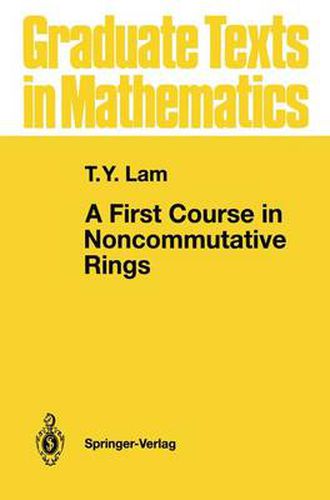Readings Newsletter
Become a Readings Member to make your shopping experience even easier.
Sign in or sign up for free!
You’re not far away from qualifying for FREE standard shipping within Australia
You’ve qualified for FREE standard shipping within Australia
The cart is loading…






This title is printed to order. This book may have been self-published. If so, we cannot guarantee the quality of the content. In the main most books will have gone through the editing process however some may not. We therefore suggest that you be aware of this before ordering this book. If in doubt check either the author or publisher’s details as we are unable to accept any returns unless they are faulty. Please contact us if you have any questions.
One of my favorite graduate courses at Berkeley is Math 251, a one-semester course in ring theory offered to second-year level graduate students. I taught this course in the Fall of 1983, and more recently in the Spring of 1990, both times focusing on the theory of noncommutative rings. This book is an outgrowth of my lectures in these two courses, and is intended for use by instructors and graduate students in a similar one-semester course in basic ring theory. Ring theory is a subject of central importance in algebra. Historically, some of the major discoveries in ring theory have helped shape the course of development of modern abstract algebra. Today, ring theory is a fer tile meeting ground for group theory (group rings), representation theory (modules), functional analysis (operator algebras), Lie theory (enveloping algebras), algebraic geometry (finitely generated algebras, differential op erators, invariant theory), arithmetic (orders, Brauer groups), universal algebra (varieties of rings), and homological algebra (cohomology of rings, projective modules, Grothendieck and higher K-groups). In view of these basic connections between ring theory and other branches of mathemat ics, it is perhaps no exaggeration to say that a course in ring theory is an indispensable part of the education for any fledgling algebraist. The purpose of my lectures was to give a general introduction to the theory of rings, building on what the students have learned from a stan dard first-year graduate course in abstract algebra.
$9.00 standard shipping within Australia
FREE standard shipping within Australia for orders over $100.00
Express & International shipping calculated at checkout
This title is printed to order. This book may have been self-published. If so, we cannot guarantee the quality of the content. In the main most books will have gone through the editing process however some may not. We therefore suggest that you be aware of this before ordering this book. If in doubt check either the author or publisher’s details as we are unable to accept any returns unless they are faulty. Please contact us if you have any questions.
One of my favorite graduate courses at Berkeley is Math 251, a one-semester course in ring theory offered to second-year level graduate students. I taught this course in the Fall of 1983, and more recently in the Spring of 1990, both times focusing on the theory of noncommutative rings. This book is an outgrowth of my lectures in these two courses, and is intended for use by instructors and graduate students in a similar one-semester course in basic ring theory. Ring theory is a subject of central importance in algebra. Historically, some of the major discoveries in ring theory have helped shape the course of development of modern abstract algebra. Today, ring theory is a fer tile meeting ground for group theory (group rings), representation theory (modules), functional analysis (operator algebras), Lie theory (enveloping algebras), algebraic geometry (finitely generated algebras, differential op erators, invariant theory), arithmetic (orders, Brauer groups), universal algebra (varieties of rings), and homological algebra (cohomology of rings, projective modules, Grothendieck and higher K-groups). In view of these basic connections between ring theory and other branches of mathemat ics, it is perhaps no exaggeration to say that a course in ring theory is an indispensable part of the education for any fledgling algebraist. The purpose of my lectures was to give a general introduction to the theory of rings, building on what the students have learned from a stan dard first-year graduate course in abstract algebra.